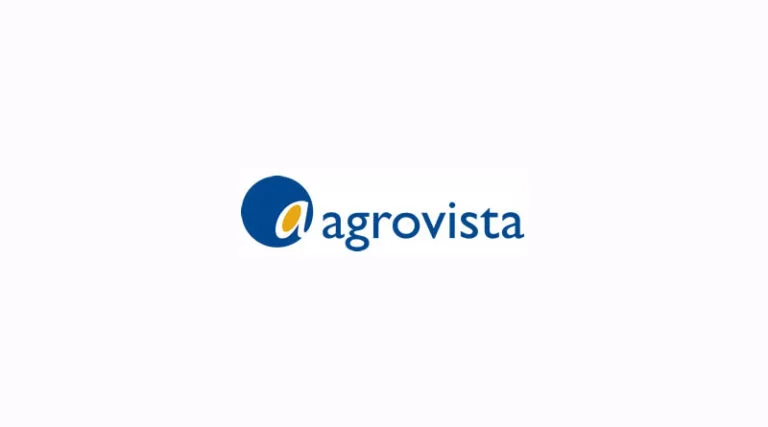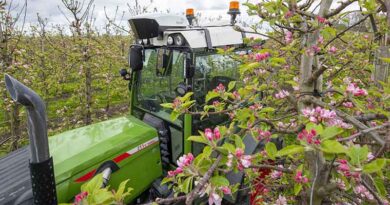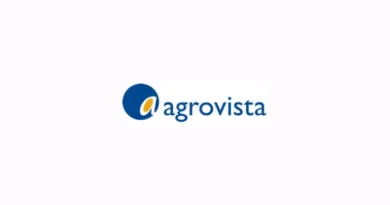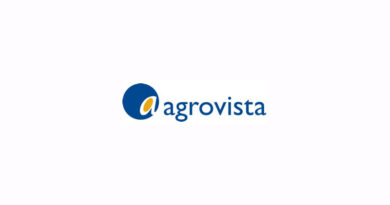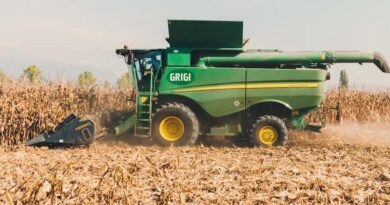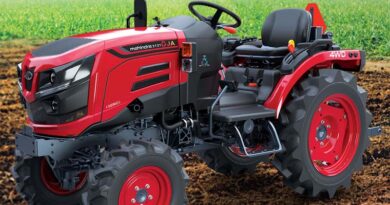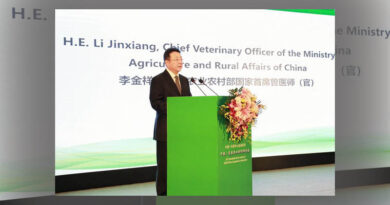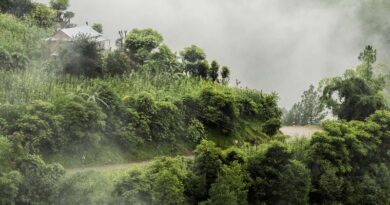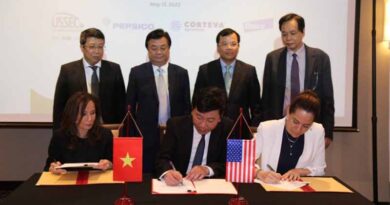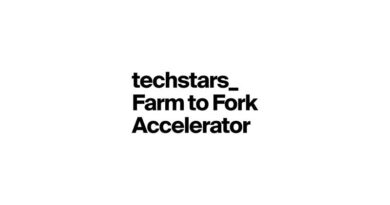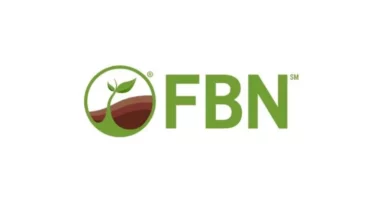Tractor-mounted sensor raises level of precision
11 August 2023, UK: Tractor-mounted sensor raises level of precision
New tractor-mounted sensor raises level of precision farming in UK orchards
Over the past two seasons, Agrovista’s blossom counting and vigour assessment mapping services have been providing apple growers with a quick, easy and economical method of collecting the data they need by drone to help maximise production of first-class fruit.
Now, further improvement to the service, developed in association with Dutch crop intelligence specialist Aurea Imaging, is imminent following the recent UK launch of Aurea’s tractor-mounted sensor, the TMS TreeScout, replacing drones as the primary source of information gathering.
So what is on offer at the moment, and what additional benefits will the new sensor deliver?
Blossom counting
Optimum blossom levels are vital to produce ideal fruit loads, but achieving those levels relies on accurate flower counts to target ammonium thiosulphate (ATS) applications to thin overly dense trees.
Growers have traditionally evaluated blossom load by manually assessing several trees per orchard, taking into account the flowering period and stages of flower development on different ages of wood, which is labour intensive and slow.
Agrovista’s current drone service has revolutionised this process. Agrovista fruit agronomist and fruit precision lead, Tom Johnson, says: “The drone can cover about 10ha per hour while assessing the percentage of blossom load on each tree. The resulting analysis and orchard density map, produced by Aurea Imaging, is more than 90% accurate.
“Treating each tree as an individual, rather than treating the whole orchard as one, leads to the additional benefits of a more homogenous orchard. Growers, with their agronomists, can more accurately match ATS applications to need using GPS-guided variable rates, producing a more uniform fruit set and improving quality and yield consistency.
“At its simplest, if aiming for 60-65mm fruit, most varieties with a low blossom count will require all those flowers. But some varieties, like Gala. produce very high levels of blossom, which, without intervention, would produce a large crop of small fruits.”
“Agronomist and grower will also take account of other factors such as historical records, experience, current weather and planned timings before deciding whether to reduce the number of viable flowers or ensure that all flowers set to produce a crop.”
Vigour mapping
Vigour mapping is an equally useful management tool, helping growers to hit target fruit load by balancing vegetative growth and fruit bud set.
Excessive shoot growth can reduce flowering potential, but can vary widely within and between orchards, depending on soil type, nutrition, and water availability.
Agrovista’s vigour mapping service measures crop height, canopy volume and vigour using the drone, rapidly identifying areas that require attention. Remedial operations include targeted PGR applications, variable rate nitrogen inputs and/or GPS-guided root pruning, which can result in significant savings.
Last season, one customer used the information to accurately target the most vigorous trees, which meant just 40% of the orchard was root pruned rather than the more usual 100%.
“We are aiming to improve uniformity within a field,” says Tom. “This is particularly important with varieties prone to biennial bearing.”
Vigour mapping also helps pinpoint poorer-performing areas of the orchard, which, in conjunction with Agrovista’s Soil Health service, can help identify soil problems and potential solutions.
Precision operations increasing
Tom believes the arrival of TreeScout, combined with the ever-increasing area of fruit planted on an intensive post-and-wire system which is ideally suited to scanning, could see a big increase in precision operations in UK apple orchards.
“This year, using drones, we’ve blossom mapped three times the area we scanned in 2022,” he says. “That’s a big jump in 12 months, but the arrival of TreeScout, which that growers can own and operate themselves, is likely to lead to an even bigger increase for next season.”
According to Bert Rijk, chief executive of Aurea Imaging, TreeScout will simplify and increase reliability of the data-gathering process, further helping growers to increase yields and reduce inputs, benefiting revenues and the environment.
Drones are a good starting point to this sort of precision technology, but also have their downsides, Bert says. “Drones are low barrier to entry – growers don’t have to invest, they can easily explore and become familiar with the technology.
“But, organisationally and logistically, using drones can be quite complex. Apple blossom, for example, can sometimes only be accurately assessed for a couple of days a year, and window of opportunity can move forward or back depending on weather.”
TreeScout benefits
With the TreeScout, which integrates with existing RTK GPS receivers, growers control their own data collection, removing dependence on external providers and logistics. “It also removes quite a bit of cost, especially if want to for more than once through the season,” Bert adds.
“The TreeScout is more scalable. On average, a tractor drives through an orchard about 30 times a season, so you can monitor every stage of the growing season without any external cost or dependencies, while collecting a lot more data.”
While this is not necessary for blossom counting and vigour assessment, there are plans to add fruit count to improve yield forecasts, apple sizing, colour estimation and, longer term, pest and disease monitoring. “We are really excited about the potential for the range of agronomic insights that will be realised as we scale the application,” says Bert.
A drone can cover 10ha per hour, but TreeScout is no slouch either, able to operate at up to 8km/hour. “It also offers improved viewing angles, more horizontal than vertical, so overall offers more frequent, higher detail data collection and analysis than a drone,” says Bert.
Information is sent to Aurea’s cloud platform for processing and mapping. Unlike a drone, where all raw data has to be uploaded, TreeScout has on-board processing computers, that carries out data analysis in real time.
“We don’t have to send all the raw imagery to the cloud, which will really help growers and will eventually allow for real-time see-and-spray type applications as they are developed,” says Bert.
TreeScout’s economic benefits appear to stack up well. Work carried out on precision thinning in the Netherlands, in a commercial orchard with a high variation in blossom density, showed a yield uplift of 6t/ha, worth just over €3100/ha (£2600/ha). The result was independently assessed by the University of Wageningen.
This figure appears typical, according to further work carried out in the Netherlands, France, Italy and the US. “The overall value will depend on blossom variation, but this is usually significant in apple orchards, especially in alternate bearing sensitive varieties,” says Bert.
The increase excludes hardware and software purchase costs, which are yet to be finalised, but Aurea estimates that improved returns from just a few hectares will cover these. Aurea expects to sell TreeScout as a package, which will include a licence for three years of software and analytics.
The first batch of beta units are now on farm and, after four seasons of testing, the unit will be available commercially in the first quarter of 2024.
Agronomy support
Expert agronomy back-up is vital with to ensure maps are interpreted correctly and the correct agronomic decisions are made.
“That is why we have chosen Agrovista as our agronomy partner,” says Bert. “You can’t just throw technology at growers without providing support.
“Agronomics differ around the world, so we need a good regional agronomy partner that provides the context and experience to help implementation in the grower’s day-to-day operations and realise the full benefits. Plus Agrovista is a very forward-looking company and has done an excellent job providing support for these new technologies.”
Tom says the partnership will improve the agronomic potential of orchards under Agrovista’s care, helping customers manage their businesses more efficiently and more profitably.
“Our experience over the past three years shows the significant potential precision management has to offer in the top fruit sector. We are very pleased to be partnering Aurea in these developments – a system like this needs careful interpretation and the relevant agronomic intervention and support, and together we believe we can add significant value to our growers’ operations.”
A promising breakthrough
The UK launch of the tractor-mounted system took place at Wingham in Kent, hosted by Adrian Scripps, one of the UK’s largest top fruit growers.
The business grows apples, blackcurrants and grapes across 750ha in Kent. Pioneering innovation and continuous investment are key to help the company produce the best quality fruit, whilst aligning with the company’s aim to increase the use of environmentally sensitive and sustainable methods.
As such, the business has proved an ideal testbed for Aurea’s precision operations, and it has been operating a beta version of the TreeScout this season.
Senior farms manager Russell Graydon says the company contacted Aurea after seeing some of their promotional work.
“We have our own drones, but have been using Aurea’s portal for the past two seasons. We are still at the trial stage at the moment but the work so far looks promising.”
Russell and his team put a lot of work into blossom thinning and vigour control. “It’s crucial to managing crop load and tree/fruit nutrition,” he says.
“Traditionally, for blossom assessment, we have counted by hand using a marker tree system. For tree vigour, we have been using visual assessments and/or leaf node counting.”
Whilst the drone-based system has been a major step forward, the advent of a tractor mounted system is set to improve matters further.
“The TreeScout offers the potential to gather information weekly should we need to. Although operating our own drones gives us more flexibility than depending on an outside provider, the fact we can collect information from the sprayer means we have one less job to do, which must be good news.
“From what I’ve seen so far, I believe Aurea’s precision mapping service, along with the new TreeScout, will be a great aid to our marketing and storage planning.”
(For Latest Agriculture News & Updates, follow Krishak Jagat on Google News)

